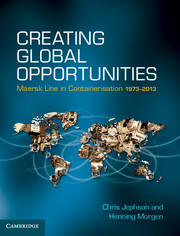Book contents
- Frontmatter
- Dedication
- Contents
- List of figures
- List of tables
- List of Economist Intelligence Unit data
- List of boxes
- Acknowledgements
- Glossary
- Prologue
- 1 ‘Per Aspera Ad Astra’
- 2 The Coming Revolution
- 3 The Decision
- 4 Building the Base (1978–1984)
- 5 Planning the Next Steps (1984–1987)
- 6 Laying the Foundations for Expansion (1987–1990)
- 7 The 1990s
- 8 The Acquisition Trail (1992–1998)
- 9 1999 A Year of Developments and Acquisitions
- 10 Into the New Millennium (2000–2005)
- 11 P&O NedLloyd (2005–2007)
- 12 A New Strategy (2008–2013)
- Epilogue
- Notes and References
- Index
Prologue
Published online by Cambridge University Press: 05 April 2014
- Frontmatter
- Dedication
- Contents
- List of figures
- List of tables
- List of Economist Intelligence Unit data
- List of boxes
- Acknowledgements
- Glossary
- Prologue
- 1 ‘Per Aspera Ad Astra’
- 2 The Coming Revolution
- 3 The Decision
- 4 Building the Base (1978–1984)
- 5 Planning the Next Steps (1984–1987)
- 6 Laying the Foundations for Expansion (1987–1990)
- 7 The 1990s
- 8 The Acquisition Trail (1992–1998)
- 9 1999 A Year of Developments and Acquisitions
- 10 Into the New Millennium (2000–2005)
- 11 P&O NedLloyd (2005–2007)
- 12 A New Strategy (2008–2013)
- Epilogue
- Notes and References
- Index
Summary
Without the container the global village would still be a concept, not a reality, because manufacturing would still be a local process.
C. C. Tung, CEO of Orient Overseas Container Line (OOCL), 1997A dynamic but challenging industry
For many, 2008 was a good year – even for some in the shipping industry, with growth in both their businesses and profits. But 2008 was a very tough year for Maersk Line.
Three years earlier, Maersk Line had started the acquisition of a major competitor, P&O NedLloyd. Following approval by the authorities in February 2006, integration proceeded quickly and everything was to be in place within six months. Enormous efforts were made by both organisations to merge the numerous offices around the world – Maersk Line alone had 325 offices in 125 countries.
The newly merged organisation had grown to over 30,000 people from the 22,000 originally in Maersk Line. The fleet had expanded similarly, from about 350 container ships to a fleet of over 600, both owned and chartered. Structuring the fleet network, already a challenging task, now became very complex.
- Type
- Chapter
- Information
- Creating Global OpportunitiesMaersk Line in Containerisation 1973–2013, pp. 1 - 8Publisher: Cambridge University PressPrint publication year: 2014



